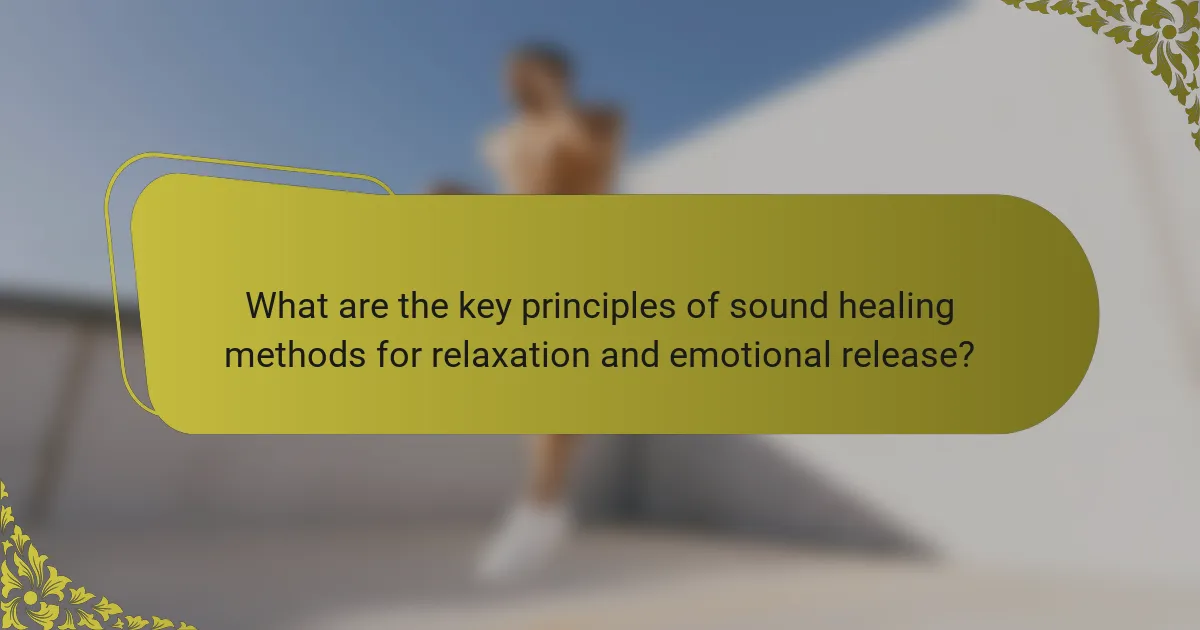Sound healing methods effectively promote relaxation and emotional release through vibrational frequencies. Key principles include the use of sound waves, resonance, and intention. Various instruments like singing bowls, gongs, and tuning forks create unique soundscapes that enhance the healing experience. Regular practice can lead to improved mental clarity and emotional balance.

What are the key principles of sound healing methods for relaxation and emotional release?
Sound healing methods promote relaxation and emotional release through vibrational frequencies. Key principles include the use of sound waves, resonance, and intention.
Sound waves can induce deep relaxation by lowering heart rates and reducing stress. Resonance occurs when sound frequencies align with the body’s natural vibrations, enhancing emotional release. Intention focuses the healing process, amplifying the effects of sound therapy.
Incorporating instruments like singing bowls, gongs, and tuning forks creates diverse soundscapes that facilitate healing. Each instrument offers unique attributes; for example, singing bowls produce calming tones, while gongs create expansive sound experiences.
Regular practice of sound healing can lead to improved mental clarity and emotional balance. Engaging with these methods consistently enhances overall well-being and fosters a deeper connection to self.
How do sound frequencies impact the mind and body?
Sound frequencies significantly impact the mind and body by promoting relaxation and emotional release. Different sound healing methods, such as binaural beats and singing bowls, utilize specific frequencies to reduce stress and enhance mental clarity.
Binaural beats, for instance, create auditory illusions that can synchronize brainwave activity, fostering deeper states of relaxation. Singing bowls produce harmonic vibrations that resonate within the body, facilitating emotional release and physical healing.
Research indicates that sound frequencies can lower cortisol levels, improve mood, and enhance overall well-being. For example, listening to calming frequencies for just 30 minutes may lead to noticeable reductions in anxiety and tension.
Incorporating sound healing into daily routines can create a more balanced emotional state and improve mental health. Regular engagement with these methods fosters resilience against stress and promotes a holistic approach to wellness.
What role does vibration play in emotional healing?
Vibration plays a crucial role in emotional healing by facilitating relaxation and emotional release. Sound healing methods utilize specific frequencies to resonate with the body, promoting a sense of calm and well-being.
The vibrational energy from sound waves can help release stored emotions, reduce stress, and enhance emotional clarity. For example, Tibetan singing bowls produce vibrations that penetrate the body, encouraging deep relaxation and emotional release.
Research indicates that sound frequencies can lower cortisol levels, which are associated with stress. This physiological response can lead to improved emotional health and resilience.
Incorporating vibration through sound healing practices can foster a deeper connection to one’s emotions, leading to transformative healing experiences.
Why is intention important in sound healing practices?
Intention is crucial in sound healing practices as it directs the energy and focus of the session. When practitioners set a clear intention, it enhances the effectiveness of sound frequencies in promoting relaxation and emotional release. This conscious approach aligns the mind and body, creating a deeper connection to the healing process. Additionally, intention fosters a safe space, allowing participants to explore their emotions and experiences more freely. Overall, a well-defined intention amplifies the benefits of sound healing, making it a transformative experience.

Which sound healing instruments are most effective for relaxation?
Sound healing instruments like singing bowls, gongs, and tuning forks are highly effective for relaxation. Singing bowls produce soothing tones that help reduce stress and promote tranquility. Gongs create deep vibrations that can facilitate emotional release. Tuning forks provide precise frequencies that align with the body’s energy centers, enhancing relaxation. Each instrument uniquely contributes to a calming atmosphere, making them popular choices in sound therapy.
What are the benefits of using singing bowls in sound therapy?
Using singing bowls in sound therapy promotes relaxation and emotional release. The vibrations from the bowls create a calming atmosphere, reducing stress and anxiety. They help balance energy and enhance meditation practices. Research indicates that sound therapy can lower blood pressure and improve overall well-being. Singing bowls may also facilitate emotional release by encouraging introspection and self-awareness, allowing individuals to process feelings more effectively.
How do tuning forks contribute to emotional release?
Tuning forks contribute to emotional release by creating vibrations that resonate with the body. These vibrations help to release stored emotional tension, promoting relaxation and balance. The sound waves produced can stimulate the nervous system, encouraging a state of calmness and emotional clarity. As a result, individuals often experience a sense of relief and heightened awareness of their emotions.
What is the significance of gongs in sound healing sessions?
Gongs play a vital role in sound healing sessions by promoting relaxation and emotional release. Their resonant tones create a deep, immersive experience that facilitates stress reduction and emotional balance. The vibrations from gongs can penetrate the body, encouraging the release of tension and fostering a meditative state. Additionally, gongs are unique in their ability to harmonize with the body’s energy centers, enhancing the overall healing process. This unique attribute sets them apart from other sound healing instruments. As a result, many practitioners incorporate gongs into their sessions to maximize therapeutic benefits.

How can sound healing be integrated into daily routines for stress relief?
Sound healing can be seamlessly integrated into daily routines through various methods. Incorporating sound baths, tuning forks, and singing bowls into morning or evening rituals promotes relaxation and emotional release.
Start with a 10-minute sound bath using recorded frequencies to set a calming atmosphere. Utilize tuning forks for targeted stress relief during breaks. Incorporate singing bowls during meditation sessions to enhance emotional processing.
Regular practice can lead to significant reductions in stress levels, as sound frequencies influence brainwave patterns. Aim for consistency; even short sessions can yield benefits over time.
What are some practical sound healing exercises for home use?
Sound healing exercises for home use include techniques like singing bowls, chanting, and listening to calming soundscapes. These methods promote relaxation and emotional release.
1. Singing Bowls: Use a crystal or metal singing bowl. Strike it gently and let the sound resonate, allowing vibrations to wash over you. This method aids in stress relief and mental clarity.
2. Chanting: Practice simple chants or mantras. Repeating phrases like “Om” can create a meditative state, fostering emotional release and grounding.
3. Soundscapes: Listen to recordings of nature sounds or ambient music. This can enhance relaxation and help you connect with your emotions.
4. Tuning Forks: Use tuning forks to create specific frequencies. Placing them on or near the body can promote healing and balance energy.
5. Breath and Sound: Combine deep breathing with vocal exercises. Inhale deeply, then exhale while making a sound. This practice can release pent-up emotions and promote calmness.
Which meditation techniques incorporate sound healing elements?
Meditation techniques that incorporate sound healing elements include sound baths, chanting, and Tibetan singing bowls. These methods utilize vibrations and frequencies to promote relaxation and emotional release. Sound baths immerse participants in harmonious sounds, while chanting focuses on vocal resonance. Tibetan singing bowls create soothing tones that facilitate deep meditation and healing. Each technique enhances the meditative experience through auditory stimulation.

What unique sound healing practices are found in different cultures?
Various cultures utilize unique sound healing practices for relaxation and emotional release. Tibetan singing bowls create resonant vibrations that promote deep relaxation. In Native American traditions, drumming circles facilitate communal healing through rhythmic sound. Indian classical music employs ragas, which evoke specific emotions and states of mind. Australian Aboriginal didgeridoo playing is believed to restore balance and promote spiritual well-being. Each method embodies cultural significance and distinct sound attributes, enhancing emotional release and relaxation.
How does Native American flute music facilitate emotional release?
Native American flute music facilitates emotional release by promoting relaxation and introspection. The soothing tones resonate with listeners, helping to alleviate stress and anxiety. This music often incorporates natural rhythms, creating a meditative atmosphere that encourages emotional expression. The unique sound of the flute can evoke deep feelings, allowing individuals to process and release pent-up emotions effectively. Additionally, the cultural significance of the music enhances its therapeutic impact, connecting listeners to a rich heritage of sound healing practices.
What are the characteristics of Tibetan sound healing traditions?
Tibetan sound healing traditions focus on using sound for relaxation and emotional release. Key characteristics include the use of specific instruments like singing bowls, which produce resonant tones that promote deep meditation. The practice emphasizes the vibrational frequency of sound, believed to align energy centers in the body. Additionally, these traditions incorporate chanting and mantras, enhancing emotional clarity and spiritual connection. The unique attribute of Tibetan sound healing is its integration of ancient Buddhist principles, fostering a holistic approach to well-being.

Which rare sound healing methods are gaining popularity in modern wellness?
Rare sound healing methods gaining popularity include gong baths, crystal singing bowls, and overtone chanting. These techniques promote relaxation and emotional release through unique auditory experiences. Gong baths immerse participants in resonant sound waves, facilitating deep meditative states. Crystal singing bowls utilize specific frequencies to align chakras, enhancing emotional balance. Overtone chanting creates harmonics that can evoke profound emotional responses. Each method offers distinct benefits, appealing to individuals seeking alternative wellness practices.
How is binaural beat therapy used for emotional balance?
Binaural beat therapy promotes emotional balance by using sound frequencies to synchronize brainwaves. This technique creates a calming effect, helping to reduce anxiety and improve mood. Research indicates that listening to binaural beats can lower stress levels and enhance emotional well-being. Users often report greater emotional clarity and resilience after regular sessions.
What is the impact of sound baths on mental health?
Sound baths positively impact mental health by promoting relaxation and emotional release. These sessions utilize sound frequencies to reduce stress, anxiety, and depression. Research indicates that sound healing can lower cortisol levels, enhancing overall well-being. Participants often report feelings of calmness and clarity, contributing to improved emotional regulation. The unique attribute of sound baths is their ability to create immersive experiences that facilitate deep meditative states. As a result, many individuals find sound healing an effective complementary therapy for mental health challenges.

What common mistakes should be avoided in sound healing practices?
To enhance sound healing practices, avoid common mistakes like neglecting proper intention, using inappropriate sound frequencies, and failing to create a conducive environment. Prioritize participant comfort and ensure consistency in practice. Misalignment with personal healing goals can hinder emotional release.
How can one ensure the effectiveness of sound healing sessions?
To ensure the effectiveness of sound healing sessions, focus on creating a calming environment, selecting appropriate sound frequencies, and establishing clear intentions. A serene setting promotes relaxation, while specific frequencies can target emotional release. Setting intentions helps participants engage more deeply with the process. Regular feedback from participants can also enhance future sessions.
What are the signs that sound healing is working?
Signs that sound healing is working include feelings of deep relaxation, emotional release, and physical sensations. Participants may experience reduced anxiety, improved mood, and heightened awareness. Additionally, some report physical responses like tingling or warmth. These indicators suggest that sound frequencies are effectively promoting healing and well-being.
What expert tips can enhance the sound healing experience?
To enhance the sound healing experience, focus on creating a calming environment, using high-quality instruments, and incorporating mindfulness techniques.
Set the space with soft lighting and comfortable seating to promote relaxation. Choose instruments like singing bowls or gongs known for their deep resonance and therapeutic effects. Mindfulness practices, such as deep breathing or guided visualization, can deepen emotional release and relaxation during sessions.
Experiment with different sound frequencies, as specific tones may resonate better with individual participants. Encourage participants to express their feelings post-session, fostering emotional awareness and release.
